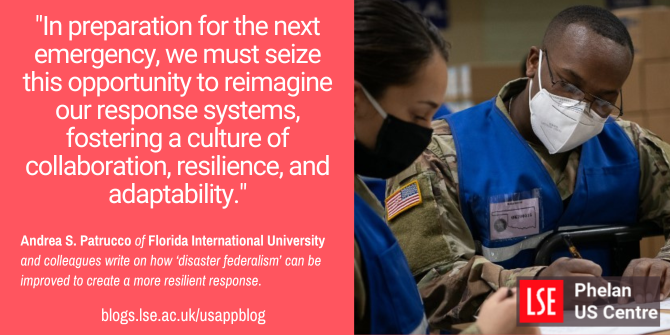 In times of nation-wide crisis, such as during the COVID-19 pandemic, the responsibility for reacting lies across the state and federal governments. Andrea S. Patrucco (and his colleagues Rob Handfield, Zhaohui Wu, Chris Yukins, and Tanner Slaughter) look at how the COVID-19 pandemic exposed the cracks in the US’ “disaster federalism”, especially in the mismanagement of the Strategic National Stockpile. He writes that the federal government’s lack of strategy during the pandemic led to an ad hoc approach to the distribution of vital resources – which deepened resource inequities -, a competitive environment for those resources, and a lack of quality and timely information. To tackle these challenges, he proposes a new model which emphasizes the effective use of the Strategic National Stockpile through strategic planning, robust allocation mechanisms, and enhanced intergovernmental coordination.
In times of nation-wide crisis, such as during the COVID-19 pandemic, the responsibility for reacting lies across the state and federal governments. Andrea S. Patrucco (and his colleagues Rob Handfield, Zhaohui Wu, Chris Yukins, and Tanner Slaughter) look at how the COVID-19 pandemic exposed the cracks in the US’ “disaster federalism”, especially in the mismanagement of the Strategic National Stockpile. He writes that the federal government’s lack of strategy during the pandemic led to an ad hoc approach to the distribution of vital resources – which deepened resource inequities -, a competitive environment for those resources, and a lack of quality and timely information. To tackle these challenges, he proposes a new model which emphasizes the effective use of the Strategic National Stockpile through strategic planning, robust allocation mechanisms, and enhanced intergovernmental coordination.
Disaster federalism, the intricate interplay between state, local, and federal governments in times of crisis, has long been hailed as the cornerstone of effective disaster response. Yet, three years after the catastrophic COVID-19 pandemic tested our nation’s resilience, we find ourselves grappling with a disheartening truth—there is still no clear path to improve this critical framework. In our new work we embark on a journey to unravel the enigma of disaster federalism and start a dialogue that challenges the status quo.
Revealing the cracks in Disaster Federalism
When disaster strikes, the fate of our nation lies in the hands of a complex web of governmental entities, each with its own powers, responsibilities, and limitations. State and local authorities, armed with “police power,” assume the frontline duty of pandemic response, wielding the ability to regulate behavior and implement localized measures. In contrast, the federal government’s scope is primarily limited to the utilization of financial resources, lacking direct regulatory authority in matters of public health.
It is within this intricate dance of federalism that the true challenges of disaster response unfold. During the COVID-19 pandemic, we witnessed a disheartening state of “federal inaction, indifference, and sometimes outright hostility” in the United States. This disconnect can be partially attributed to the federalist structure of our government, which assigns powers and responsibilities between state and local governments and the federal government. While state and local governments bear frontline response duties, the federal government’s role primarily revolves around allocating funds and acquiring and distributing resources. Consequently, the COVID-19 pandemic mercilessly exposed the cracks in our system, as federal inaction, indifference, and a lack of cohesive coordination hindered an effective response.
Particularly, the Strategic National Stockpile (SNS) – the US’ national stock of antibiotics, vaccines, and other important medical supplies, which is supposed to act as a safeguard against crises, stood neglected and ill-equipped to meet the unprecedented demands of the pandemic. Before the pandemic, the Strategic National Stockpile (SNS) had not been adequately replenished for years, leading to critical shortages of personal protective equipment (PPE) and expired medical supplies. Despite attempts to address these issues through the Defense Production Act (DPA) and production orders, the supply of essential medical equipment remained insufficient, perpetuating a state of shortage. These shortages of critical supplies, expired equipment, and misguided allocation efforts underscored the urgent need for reform.
The egregious mismanagement of the SNS attracted justified scrutiny. Diversion of funds intended for PPE, contracting disputes leading to diminished ventilator shipments, and the depletion of critical materials without timely federal response exacerbated the crisis. The absence of a clear federal government role and intergovernmental clashes further impeded a swift and effective response, resulting in unnecessary loss of life.

“Oklahoma National Guard” (CC BY 2.0) by The National Guard
Resource Distribution Woes
Our research delves deep into the complexities of disaster federalism, exposing the systemic failures that hinder effective response. Through our engagements with state officials, we unearthed a startling revelation— during the COVID-19 pandemic, the federal government lacked a coherent strategy for equitable resource allocation, which created a snowballing series of events.
The ad hoc approach to distribution meant that there were no standardized criteria or guidelines for allocating resources. The absence of clear guidelines created inconsistencies and disparities in the distribution process, leading to unequal access to critical resources such as PPE.
This lack of standardized criteria created a competitive environment among states and entities, where each sought to secure as many resources as possible for their own needs. This competition led to hoarding and stockpiling of supplies by some entities, exacerbating the shortages in other areas.
Random distribution and competitive reactions from state and local agencies made it very difficult to share high-quality and timely information among different entities involved in the supply chain. Particularly, the lack of transparency and centralized data sharing made it challenging to track the availability and movement of resources effectively.
Without a coordinated system in place, resources remained in regions or facilities with excess stock, while areas in desperate need struggled to access the necessary supplies. This lack of efficient redistribution further deepened the inequities in resource distribution.
Figure 1 – Ineffective disaster federalism response during COVID-19: relevant factors
As we reflect on the aftermath of the COVID-19 disaster, we must confront the unsettling reality that our understanding of disaster federalism remains incomplete, leaving us without a clear roadmap to improve our response systems. This realization compels us to embark on a thought-provoking journey towards resilience and transformation.
A Call for Transformation
To address these challenges, we propose a new acquisition model that emphasizes the effective utilization of the Strategic National Stockpile. This model comprises three key components: strategic planning, robust allocation mechanisms, and enhanced intergovernmental coordination.
- Strategic planning involves regular replenishment of the SNS, ensuring up-to-date and readily available critical supplies. It also entails developing a comprehensive acquisition strategy that considers potential threats and disasters.
- Robust allocation mechanisms should be established to ensure equitable distribution of resources based on need and vulnerability. This requires coordination and information sharing between federal, state, and local governments, as well as the involvement of relevant stakeholders and experts.
- Enhanced intergovernmental coordination is crucial for an effective disaster response. Clear guidelines and protocols should be established to define the roles and responsibilities of different levels of government, ensuring seamless cooperation and minimizing conflicts.
The enigma of disaster federalism persists, urging us to push the boundaries of our understanding and embrace transformative change. In preparation for the next emergency, we must seize this opportunity to reimagine our response systems, fostering a culture of collaboration, resilience, and adaptability. Only by embarking on this collective journey can we unlock the true potential of federal disaster response and safeguard our nation against the perils of future crises.
- This article is based on the paper, ‘A new acquisition model for the next disaster: Overcoming disaster federalism issues through effective utilization of the Strategic National Stockpile’ in Public Administration Review.
- Please read our comments policy before commenting.
- Note: This article gives the views of the author, and not the position of USAPP – American Politics and Policy, nor the London School of Economics.
- Shortened URL for this post: https://bit.ly/44DUF6q






